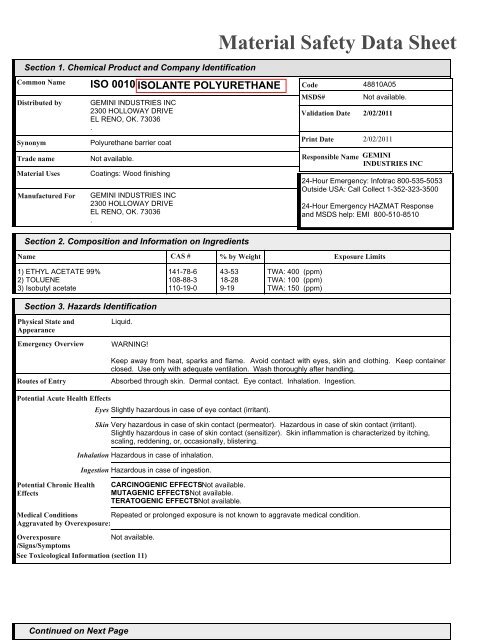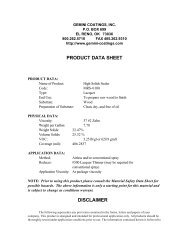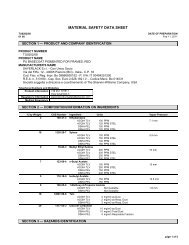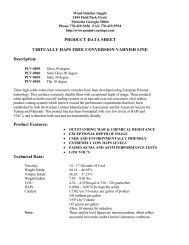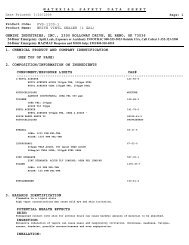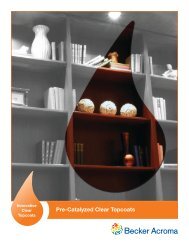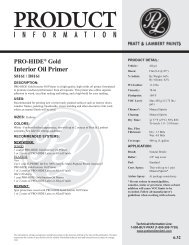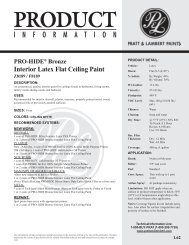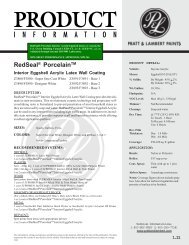Material Safety Data Sheet
Material Safety Data Sheet
Material Safety Data Sheet
You also want an ePaper? Increase the reach of your titles
YUMPU automatically turns print PDFs into web optimized ePapers that Google loves.
<strong>Material</strong> <strong>Safety</strong> <strong>Data</strong> <strong>Sheet</strong>Section 1. Chemical Product and Company IdentificationCommon NameDistributed bySynonymTrade name<strong>Material</strong> UsesManufactured ForISO 0010GEMINI INDUSTRIES INC2300 HOLLOWAY DRIVEEL RENO, OK. 73036.Polyurethane barrier coatNot available.Coatings: Wood finishingGEMINI INDUSTRIES INC2300 HOLLOWAY DRIVEEL RENO, OK. 73036.CodeMSDS#Validation DatePrint DateIn Case ofEmergency48810A05Not available.2/02/20112/02/2011Responsible Name GEMINIINDUSTRIES INCEmergency phone: Chemtrec:1-800-424-9300Section 2. Composition and Information on IngredientsName CAS # % by Weight Exposure Limits1) ETHYL ACETATE 99% 141-78-6 43-53 TWA: 400 (ppm)2) TOLUENE 108-88-3 18-28 TWA: 100 (ppm)3) Isobutyl acetate 110-19-0 9-19 TWA: 150 (ppm)Section 3. Hazards IdentificationPhysical State andAppearanceEmergency OverviewRoutes of EntryLiquid.WARNING!Keep away from heat, sparks and flame. Avoid contact with eyes, skin and clothing. Keep containerclosed. Use only with adequate ventilation. Wash thoroughly after handling.Absorbed through skin. Dermal contact. Eye contact. Inhalation. Ingestion.Potential Acute Health EffectsEyes Slightly hazardous in case of eye contact (irritant).Potential Chronic HealthEffectsSkinInhalation Hazardous in case of inhalation.Ingestion Hazardous in case of ingestion.CARCINOGENIC EFFECTS: Not available.MUTAGENIC EFFECTS: Not available.TERATOGENIC EFFECTS: Not available.Medical Conditions Repeated or prolonged exposure is not known to aggravate medical condition.Aggravated by Overexposure:OverexposureNot available./Signs/SymptomsSee Toxicological Information (section 11)Very hazardous in case of skin contact (permeator). Hazardous in case of skin contact (irritant).Slightly hazardous in case of skin contact (sensitizer). Skin inflammation is characterized by itching,scaling, reddening, or, occasionally, blistering.Continued on Next Page
ISO 0010 Page: 2/6Section 4. First Aid MeasuresEye ContactSkin ContactInhalationIngestionNotes to PhysicianCheck for and remove any contact lenses. Immediately flush eyes with running water for at least 15minutes, keeping eyelids open. Cold water may be used. Get medical attention immediately.In case of contact, immediately flush skin with plenty of water for at least 15 minutes while removingcontaminated clothing and shoes. Cover the irritated skin with an emollient. Remove contaminatedclothing and shoes. Cold water may be used.Wash clothing before reuse. Thoroughly clean shoesbefore reuse. Get medical attention.If inhaled, remove to fresh air. If not breathing, give artificial respiration. If breathing is difficult, giveoxygen. Get medical attention if symptoms appear.Do NOT induce vomiting unless directed to do so by medical personnel. Never give anything by mouthto an unconscious person. Loosen tight clothing such as a collar, tie, belt or waistband. Get medicalattention if symptoms appear.Not available.Section 5. Fire Fighting MeasuresFlammability of the ProductAuto-ignition TemperatureFlash PointsFlammable LimitsProducts of CombustionFire Hazards in Presence ofVarious SubstancesExplosion Hazards inPresence of VariousSubstancesFire Fighting Mediaand InstructionsProtective Clothing (Fire)Flammable.The lowest known value is 422.78°C (793°F) (Isobutyl acetate).The lowest known value is CLOSED CUP: -4.4°C (24.1°F). OPEN CUP: -3°C (26.6°F). (Cleveland).(Ethyl acetate 99%)The greatest known range is LOWER: 2.2% UPPER: 11.5% (Ethyl acetate 99%)These products are carbon oxides (CO, CO2).Highly flammable in presence of open flames and sparks, of heat, of moisture.Flammable in presence of oxidizing materials.Slightly flammable to flammable in presence of reducing materials, of combustible materials.Risks of explosion of the product in presence of mechanical impact: Not available.Risks of explosion of the product in presence of static discharge: Not available.Flammable liquid, soluble or dispersed in water. Moisture reactive material.SMALL FIRE: Obtain advice on use of water. Use DRY chemical powder.LARGE FIRE: Use alcohol foam, water spray or fog. Do not use water jet.Be sure to use an approved/certified respirator or equivalent.Special Remarks on FireHazardsSpecial Remarks onExplosion HazardsVapor may travel considerable distance to source of ignition and flash back. When heated todecomposition it emits acrid smoke and irritating fumes. (Ethyl acetate 99%)NoneSection 6. Accidental Release MeasuresSmall Spill and LeakLarge Spill and LeakDilute with water and mop up, or absorb with an inert dry material and place in an appropriate wastedisposal container.Flammable liquid.Keep away from heat. Keep away from sources of ignition. Stop leak if without risk. Absorb with DRYearth, sand or other non-combustible material. Do not touch spilled material. Prevent entry intosewers, basements or confined areas; dike if needed. Be careful that the product is not present at aconcentration level above TLV. Check TLV on the MSDS and with local authorities.Continued on Next Page
ISO 0010 Page: 3/6Section 7. Handling and StorageHandlingStorageKeep away from heat, sparks and flame. Keep container closed. Use only with adequate ventilation.To avoid fire or explosion, dissipate static electricity during transfer by grounding and bondingcontainers and equipment before transferring material. Use explosion-proof electrical (ventilating,lighting and material handling) equipment.Store in a segregated and approved area. Keep container in a cool, well-ventilated area. Keepcontainer tightly closed and sealed until ready for use. Avoid all possible sources of ignition (spark orflame).Section 8. Exposure Controls/Personal ProtectionEngineering ControlsPersonal ProtectionProvide exhaust ventilation or other engineering controls to keep the airborne concentrations of vaporsbelow their respective threshold limit value. Ensure that eyewash stations and safety showers areproximal to the work-station location.Eyes <strong>Safety</strong> glasses.Protective Clothing(Pictograms)Body Lab coat.Respiratory Vapor respirator. Be sure to use an approved/certified respirator or equivalent. Wear appropriaterespirator when ventilation is inadequate.Hands Gloves.Feet Not applicable.Personal Protection in Case ofSplash goggles. Full suit. Vapor respirator. Boots. Gloves. A self contained breathing apparatusa Large Spillshould be used to avoid inhalation of the product. Suggested protective clothing might not besufficient; consult a specialist BEFORE handling this product.Product NameExposure Limits1) Ethyl acetate TWA: 400 (ppm)2) Toluol TWA: 100 (ppm)3) Isobutyl acetate TWA: 150 (ppm)Consult local authorities for acceptable exposure limits.Section 9. Physical and Chemical PropertiesPhysical State andAppearanceLiquid.OdorSolventMolecular WeightNot applicable.TasteNot available.Molecular FormulaNot applicable.ColorTransparentpH (1% Soln/Water)Neutral.Boiling/Condensation PointMelting/Freezing PointCritical TemperatureSpecific GravityVapor PressureVapor DensityThe lowest known value is 77°C (170.6°F) (Ethyl acetate 99%). Weighted average: 93.82°C (200.9°F)May start to solidify at -83.6 (-118.5°F) based on data for: Ethyl acetate 99%. Weighted average:-89.32°C (-128.8°F)N/AWeighted average: 0.88 (Water = 1)The highest known value is 9.7kPa (@ 20°C) (Ethyl acetate 99%). Weighted average: 6.31 kPa (@20°C)The highest known value is 4 (Air = 1) (Isobutyl acetate). Weighted average: 3.19 (Air = 1)Continued on Next Page
ISO 0010 Page: 4/6VolatilityVolatileOdor ThresholdEvaporation RateVOCNot available.Slower than Isobutyl Acetate723 grams/litre6.02 lbs/gallonViscosityLogK owIonicity (in Water)Dispersion Properties12 sec. Ford Cup #4 at 25°CThe product is more soluble in oil.N/ASee solubility in water, methanol, diethyl ether, n-octanol.SolubilityPhysical Chemical Comments Not available.Section 10. Stability and ReactivityEasily soluble in methanol, diethyl ether.Soluble in n-octanol.Partially soluble in cold water, hot water.Stability and ReactivityConditions of InstabilityThe product is stable.N/AIncompatibility with VariousSubstancesHazardous DecompositionProductsHighly reactive with oxidizing agents.Reactive with organic materials, acids, alkalis, moisture.Slightly reactive to reducing agents, metals.N/AHazardous PolymerizationNot available.Section 11. Toxicological InformationToxicity to AnimalsChronic Effects on HumansOther Toxic Effects onHumansSpecial Remarks on Toxicityto AnimalsSpecial Remarks on ChronicEffects on HumansSpecial Remarks on OtherToxic Effects on HumansAcute oral toxicity (LD50): 2600 mg/kg [Rat.]. (Toluene).Acute dermal toxicity (LD50): 12210 mg/kg [Rabbit.]. (Toluene).Causes damage to the following organs: blood, kidneys, the nervous system, liver.Very hazardous in case of skin contact (permeator).Hazardous in case of skin contact (irritant), of ingestion, of inhalation.Slightly hazardous in case of skin contact (sensitizer).NoneInhalation of vapors may cause dizziness, an irregular heartbeat, narcosis, nausea or asphyxiation.(Toluene)Exposure can cause nausea, headache and vomiting. <strong>Material</strong> is irritating to mucous membranes andupper respiratory tract. (Ethyl acetate 99%)Section 12. Ecological InformationEcotoxicityBOD5 and CODBiodegradable/OECDMobilityNot available.N/ANot available.Not available.Continued on Next Page
ISO 0010 Page: 5/6Toxicity of the Products ofBiodegradationPossibly hazardous short term degradation products are not likely. However, long term degradationproducts may arise.The product itself and its products of degradation are not toxic.Special Remarks on theProducts of BiodegradationNoneSection 13. Disposal ConsiderationsWaste InformationDispose in observation of local regulations. Don't abandon the product in ambient.Waste StreamN/AConsult your local or regional authorities.Section 14. Transport InformationDOT ClassificationClass 3: Flammable liquid.PAINT (including paint, lacquer, enamel, stain, shellac, varnish, polish, liquid filler and liquid lacquerbase) or PAINT RELATED MATERIAL (including paint thinning or reducing compound) (Ethyl acetate99%)1263IIMarine PollutantNot available.Hazardous SubstancesReportable QuantitySpecial Provisions forTransportTDG ClassificationADR/RID ClassificationIMO/IMDG ClassificationICAO/IATA ClassificationNot available.Not available.Class 3: Flammable liquid.Class 3: Flammable liquid A.CLASS 3.1: Flammable liquid (Low flashpoint group of liquids having a flashpoint below -18°C (0°F)c.c.).Class 3: Flammable liquid.Section 15. Regulatory InformationHCS ClassificationU.S. Federal RegulationsInternational RegulationsWHMIS (Canada)Class: Flammable liquid having a flash point lower than 37.8°C (100°F).TSCA: No products were found.SARA 302/304/311/312 extremely hazardous substances: No products were found.SARA 302/304 emergency planning and notification: No products were found.SARA 302/304/311/312 hazardous chemicals: No products were found.SARA 311/312 MSDS distribution - chemical inventory - hazard identification: No products were found.SARA 313 toxic chemical notification and release reporting: No products were found.Clean water act (CWA) 307: No products were found.Clean water act (CWA) 311: No products were found.Clean air act (CAA) 112 accidental release prevention: No products were found.Clean air act (CAA) 112 regulated flammable substances: No products were found.Clean air act (CAA) 112 regulated toxic substances: No products were found.CLASS B-2: Flammable liquid with a flash point lower than 37.8°C (100°F).Continued on Next PageCEPA DSL: All products were found.
ISO 0010 Page: 6/6EINECSDSCL (EEC)International ListsState RegulationsNot available.R11- Highly flammable.R38- Irritating to skin.R41- Risk of serious damage to eyes.No products were found.No products were found.California prop. 65: No products were found.Section 16. Other InformationLabel RequirementsHazardous <strong>Material</strong>Information System(U.S.A.)HealthFire HazardReactivityPersonal Protection* National Fire3Protection3 Association (U.S.A.)1HHealth331Fire HazardReactivitySpecific HazardReferencesOther SpecialConsiderationsIf you need references concerning this product, we will be pleased to give you the information on yourrequest.Revised: 2/02/2011.Validated by GEMINI INDUSTRIES INC on 2/02/2011.Verified by GEMINI INDUSTRIES INC.Printed 2/02/2011Emergency phone: Infotrac 800-535-5053Notice to ReaderTo the best of our knowledge, the information contained herein is accurate. However, neither the above named supplier nor any of itssubsidiaries assumes any liability whatsoever for the accuracy or completeness of the information contained herein.Final determination of suitability of any material is the sole responsibility of the user. All materials may present unknown hazards and shouldbe used with caution. Although certain hazards are described herein, we cannot guarantee that these are the only hazards that exist.


